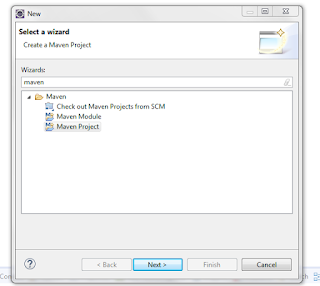1. We'll create a maven web project, in this example we'll name it RestMaven.
2. We edit the pom.xml file as follows
<project xmlns="http://maven.apache.org/POM/4.0.0" xmlns:xsi="http://www.w3.org/2001/XMLSchema-instance"
xsi:schemaLocation="http://maven.apache.org/POM/4.0.0 http://maven.apache.org/maven-v4_0_0.xsd">
<modelVersion>4.0.0</modelVersion>
<groupId>com.co</groupId>
<artifactId>RestMaven</artifactId>
<packaging>war</packaging>
<version>0.0.1-SNAPSHOT</version>
<name>RestMaven Maven Webapp</name>
<url>http://maven.apache.org</url>
<dependencies>
<dependency>
<groupId>junit</groupId>
<artifactId>junit</artifactId>
<version>3.8.1</version>
<scope>test</scope>
</dependency>
<dependency>
<groupId>javax.servlet</groupId>
<artifactId>javax.servlet-api</artifactId>
<version>3.1.0</version>
</dependency>
<dependency>
<groupId>javax.servlet</groupId>
<artifactId>jstl</artifactId>
<version>1.2</version>
</dependency>
<dependency>
<groupId>com.sun.jersey</groupId>
<artifactId>jersey-server</artifactId>
<version>1.9</version>
</dependency>
</dependencies>
<build>
<finalName>RestMaven</finalName>
</build>
</project>
3. Right click on project, select Properties -> Java Build Path and latter we remove the following directories:
4. In the same window we create a java folder as we can see in the next picture
5. Right click on project -> Properties -> Project Facets and we mark JAX-RS option as follows
6. Now we create a package in Java folder that we created in the 4 step.
com.co.RestServices.controller.controller
This package you can name it when you want.
7. We edit the web.xml file as follows
<?xml version="1.0" encoding="UTF-8"?>
<web-app xmlns:xsi="http://www.w3.org/2001/XMLSchema-instance"
xmlns="http://xmlns.jcp.org/xml/ns/javaee"
xsi:schemaLocation="http://xmlns.jcp.org/xml/ns/javaee http://xmlns.jcp.org/xml/ns/javaee/web-app_3_1.xsd"
id="WebApp_ID" version="3.1">
<display-name>Archetype Created Web Application</display-name>
<welcome-file-list>
<welcome-file>index.html</welcome-file>
<welcome-file>index.htm</welcome-file>
<welcome-file>index.jsp</welcome-file>
<welcome-file>default.html</welcome-file>
<welcome-file>default.htm</welcome-file>
<welcome-file>default.jsp</welcome-file>
</welcome-file-list>
<servlet>
<servlet-name>RestMaven</servlet-name>
<servlet-class>com.sun.jersey.spi.container.servlet.ServletContainer</servlet-class>
<init-param>
<param-name>com.sun.jersey.config.property.packages</param-name>
<param-value>com.co.RestServices.controller.controller</param-value>
</init-param>
<load-on-startup>1</load-on-startup>
</servlet>
<servlet-mapping>
<servlet-name>RestMaven</servlet-name>
<url-pattern>/rest/*</url-pattern>
</servlet-mapping>
</web-app>
8. We create a Class for management the rest service, in this example we'll calle it RestMain
package com.co.RestServices.controller.controller;
import javax.ws.rs.FormParam;
import javax.ws.rs.POST;
import javax.ws.rs.Path;
import javax.ws.rs.Produces;
import javax.ws.rs.core.MediaType;
import javax.ws.rs.core.Response;
@Path("/")
public class RestMain {
@POST
@Path("/postMain")
@Produces(MediaType.APPLICATION_JSON)
public Response postMain(@FormParam("value") String value) {
String response = "{'Message': '"+value+"'}";
return Response.ok(response, MediaType.APPLICATION_JSON).build();
}
}
9. Now we can try the rest service, in this example we use Google Advanced REST client.








No comments:
Post a Comment